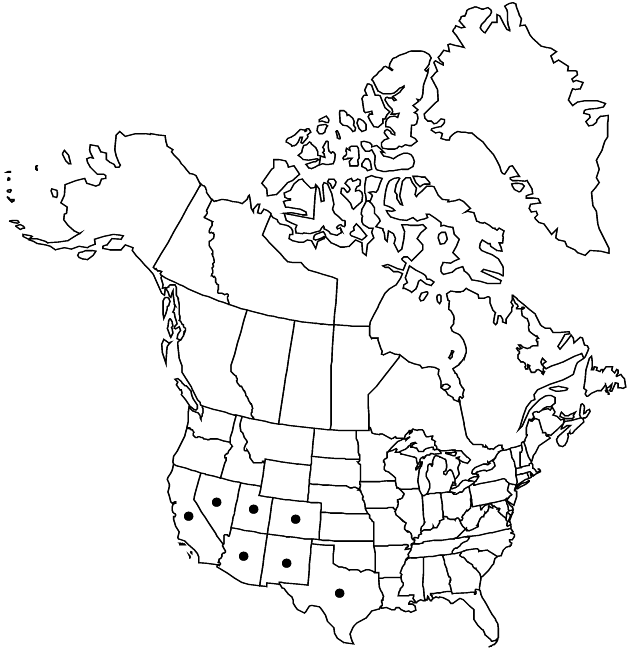Cirsium neomexicanum
Smithsonian Contr. Knowl. 5(6): 101. 1853.
Biennials, 40–290 cm; taprooted. Stems usually 1, erect, thinly gray-tomentose, sometimes ± glabrate; branches few–many, usually from above middle, ascending. Leaves: blades oblong–elliptic to oblanceolate, 6–35 × 1.5–7 cm, shallowly to deeply pinnatifid, lobes usually rigidly spreading, undivided or with 1–2 pairs of coarse teeth or lobes, main spines 5–15 mm, faces gray-tomentose, sometimes glabrate; basal often present at flowering, winged-petiolate or sessile, bases tapered, spiny-winged; principal cauline sessile, much reduced distally, bases decurrent as spiny wings less than 5 cm; distal much reduced, ± bractlike, sometimes scarcely more than a cluster of long spines. Heads 1–6 (many on large individuals), borne singly or in corymbiform arrays. Peduncles (2.5–) 5–30 cm, bracted. Involucres shallowly hemispheric or campanulate, 2–3 × 2.5–5 cm, arachnoid to ± loosely tomentose, sometimes glabrous. Phyllaries in 7–10 series, imbricate to subequal, linear to narrowly lanceolate, abaxial faces with narrow or no glutinous ridge; outer and mid bodies appressed, entire or minutely spinulose, apices deflexed to spreading or ascending, long, flat, spines spreading to reflexed, 4–15 mm; apices of inner erect, often flexuous, flat. Corollas white to pale lavender or pink, 18–27 mm, tubes 8–14 mm, throats 4–7 mm, lobes 5–9 mm; style tips 4–5 mm. Cypselae dark-brown, 5–6 mm, apical collars not differentiated; pappi 15–20 mm. 2n = 30 (as C. utahense), 32; 30 + 1 I.
Phenology: Flowering spring–summer (Mar–Jul).
Habitat: Canyons, slopes, roadsides in deserts, dry grasslands, and arid woodlands dominated by pinyon pines, junipers, oaks, Joshua trees
Elevation: 300–2100 m
Distribution

Ariz., Calif., Colo., Nev., N.Mex., Tex., Utah, Mexico (Sonora)
Discussion
Desert thistle is widespread in the Mojave and Sonoran deserts and ranges into the southern Great Basin desert, western Chihuahuan desert, and into adjacent mountains of Utah, southwestern Colorado, Arizona, and New Mexico.
The name Cirsium utahense has been widely applied in the past to plants that are here recognized as C. inamoenum. S. L. Welsh (1983) treated it as a variety of C. neomexicanum. I have examined the type of C. utahense and can find no basis for distinguishing it from C. neomexicanum at any rank. The desert thistle is closely related to C. occidentale.
Selected References
None.
Lower Taxa
"fine" is not a number.